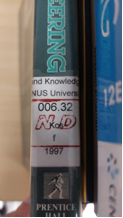Understanding Classification Numbers in Library Book Collections
Last Updated : 19 August 2025 16:24- ASO School of Engineering
- Binus Business School
- Doctor
- International Undergraduate
- Master
- Online Collaboration S1
- Online Master
- Online Undergraduate
- Regular Collaboration S1
- Regular Profession
- Undergraduate
- Undergraduate (Bandung)
- Undergraduate (Malang)
- Undergraduate (Medan)
- Undergraduate (Semarang)
A classification number is a code used to organize books in a library so that they can be easily located based on their subject or topic. This classification system plays an important role in maintaining order and helping users (patrons) find the collections they need.
One of the most widely used classification systems in libraries is the Dewey Decimal Classification (DDC) system. This system divides books into ten main classes based on subjects or fields of knowledge:
-
000 – General Works
-
100 – Philosophy and Psychology
-
200 – Religion
-
300 – Social Sciences
-
400 – Language
-
500 – Natural Sciences and Mathematics
-
600 – Technology and Applied Sciences
-
700 – Arts, Entertainment, and Sports
-
800 – Literature
-
900 – Geography and History
How Does the System Work?
The DDC system uses numbers to group books by subject. Each classification number usually consists of three levels:
-
Main Class – representing a broad discipline
-
Subclass – representing a more specific field
-
Sub-subclass – representing a detailed topic
Example:
-
510 = Mathematics
-
510.285 = Data Processing and Analysis in Mathematics
Longer classification numbers allow users to locate books that are more relevant to their topic without browsing the entire shelf.
Example of a Call Number on a Book
Below is an example of a call number found on a book at BINUS LKC (Tandon collection):

Explanation:
- 006.32 → Classification number (subject: Computer Programming)
- Kos → The first three letters of the author’s last name (Kosko, Bart)
- f → The first letter of the book title (Fuzzy Engineering)
- 1997 → Year of publication
Understanding this call number helps users navigate the library shelves efficiently and find the exact book they need.
Why Is This Important?
Knowing how to read and use classification numbers will help users:
-
Save time when searching for books
-
Maximize the benefits of library facilities
-
Use OPAC (Online Public Access Catalog) to search for books by classification number or keyword
Libraries also provide OPAC to make it easier for users to locate and access library collections quickly.
For More Information
To learn more about services and collections at the BINUS Library and Knowledge Center, please contact:
-
WhatsApp: +62 851 8307 0004
-
Email: library@binus.edu
-
Website: https://newlibrary.binus.ac.id/
-
Instagram: @binuslibrary
-
YouTube: binuslibrary
-
Linktree: linktr.ee/binuslibrary











